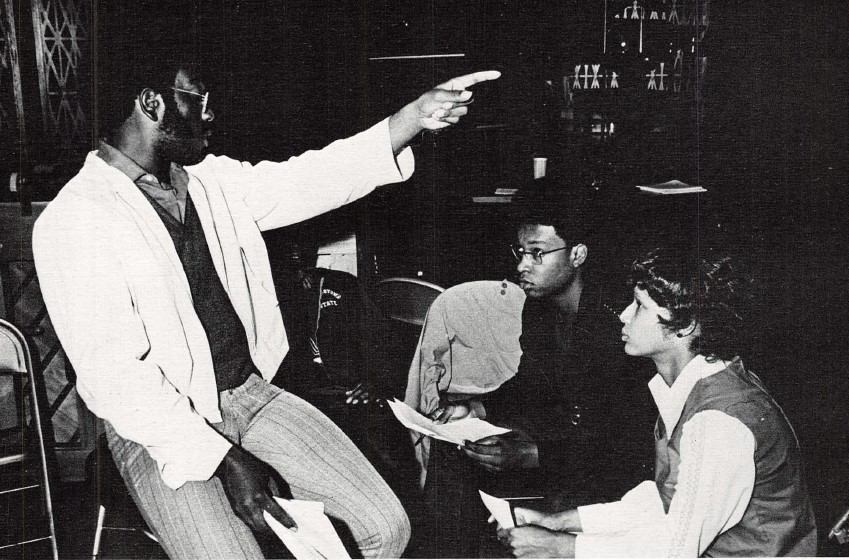By Frances Clause
Alyssa Weston
Alfred Bright, the founding director of the Youngstown State University black studies program, now known as Africana studies, in 1970 and first African American full-service faculty member at the university, recently died.
Bright was an internationally renowned artist and educator. Before becoming the first African American full-service faculty member at YSU, Bright earned a bachelor’s degree in art education in 1964 and a master’s degree in painting from Kent State University a year later.
“You came away from his courses with a sense of dignity and unique sense of pride of the accomplishments of your ancestors that had pretty much been hidden from you your whole life.”
-Marvin Haire
According to YSU archives, Bright had more than 100 solo art exhibits in his lifetime and received numerous local, state and national awards, including the Rev. Dr. Martin Luther King Jr. Diversity Award for Lifetime Achievement for his leadership and service to the Youngstown, Ohio, community in 2011.
Marvin Haire was one of the first students to pursue the black studies minor at YSU under Bright.
Haire said Bright was an inspiring factor in his decision to study black politics at Clark Atlanta University and that Bright’s original vision for the black studies program was in line with the national movement at the time.
“[The black studies program] sought to infuse the systematic study of African people into university curriculum and do that in a way that provided exposure to a wide range of what we would call the black experience, including music, art, history, politics and education,” he said. “So the original vision was to build a program that offered that kind global awareness to students who took courses.”
In Haire’s opinion, Bright’s students gained a broader perspective and deeper appreciation of who they were in terms of their social and cultural identity through his classes.
“You came away from his courses with a sense of dignity and unique sense of pride of the accomplishments of your ancestors
that had pretty much been hidden from you your whole life,” he said.
Dolores Sisco, professor in the department of English and director of American studies, has taught classes specializing in the literature and culture of the African diaspora at YSU since 2005.
Although Sisco didn’t know Bright personally, she believes she understands his vision about the Africana Studies Department and how it fits in the Youngstown community.
Sisco said that vision includes teaching the community about the black experience through Black History Month, the Youngstown African Marketplace and other local events.
Through conversations with community members, Sisco discovered early in her YSU career that the Africana studies program doesn’t just interest students coming in. It also interests older community members who were “skeptical” of what YSU did for the black community before the start of the program.
“I’m sure [Bright] wanted this to be a two-way street so that we have community involvement and not just African American involvement and what we can contribute to the community,” she said.
Bright’s Art Shines Nationally
Al Bright was not only an artist but also an abstract painter who performed alongside jazz musicians as their music accompanied each stroke of his brush on canvas.
With Trumbull Art Gallery sponsoring his first painting performance in 1976, Bright continued to paint to the rhythm of soulful sounds from bands, including Art Blakey and the Jazz Messengers. His audience was always engaged in the creative process with him.
“One aspect of [Bright’s] work that I always found appealing was that he dedicates his work to the people that he cares about,” Louis Zona, executive director at The Butler Institute of American Art, said.
As an undergraduate art education major at YSU, Zona studied under Bright.
“I was in [Bright’s] first university class and, if I am not mistaken, it was a graphic design class,” he said. “I knew him for a long time, and we were family.”
Although his contributions to the art community in Youngstown continue to have a lasting impact, it is Bright’s former students that are affected most by his legacy.
In 2005, a friend approached Jaison Lee, a former student, lab assistant and understudy of Al Bright.
“[My friend] told me about this amazing painting professor that I just had to take, so I decided on Al,” he said. “It was not a mistake.”
Lee said he fell under Bright’s wing and studied the same things that gave Bright passion. Becoming inspired, Lee also began his own painting performances after assisting with many of his professor’s.
“His career started in times of very strong racial bias where lots of opportunities for minority artists lacked hugely, let alone those pursuing to instruct at the college level,” he said.
Al Bright was not only an artist but also a friend, mentor and inspiration to those that had the privilege of learning from him or watching each stroke of his brush on his canvas of life.
His legacy lives on in various permanent art collections, including those at the Butler Institute of American Art, Kent State University Gallery, Roanoke Museum of Fine Arts, Northeastern University, Savannah State University, the Harmon and Harriet Kelley Collection of African American Art and the Canton Museum of Art.
